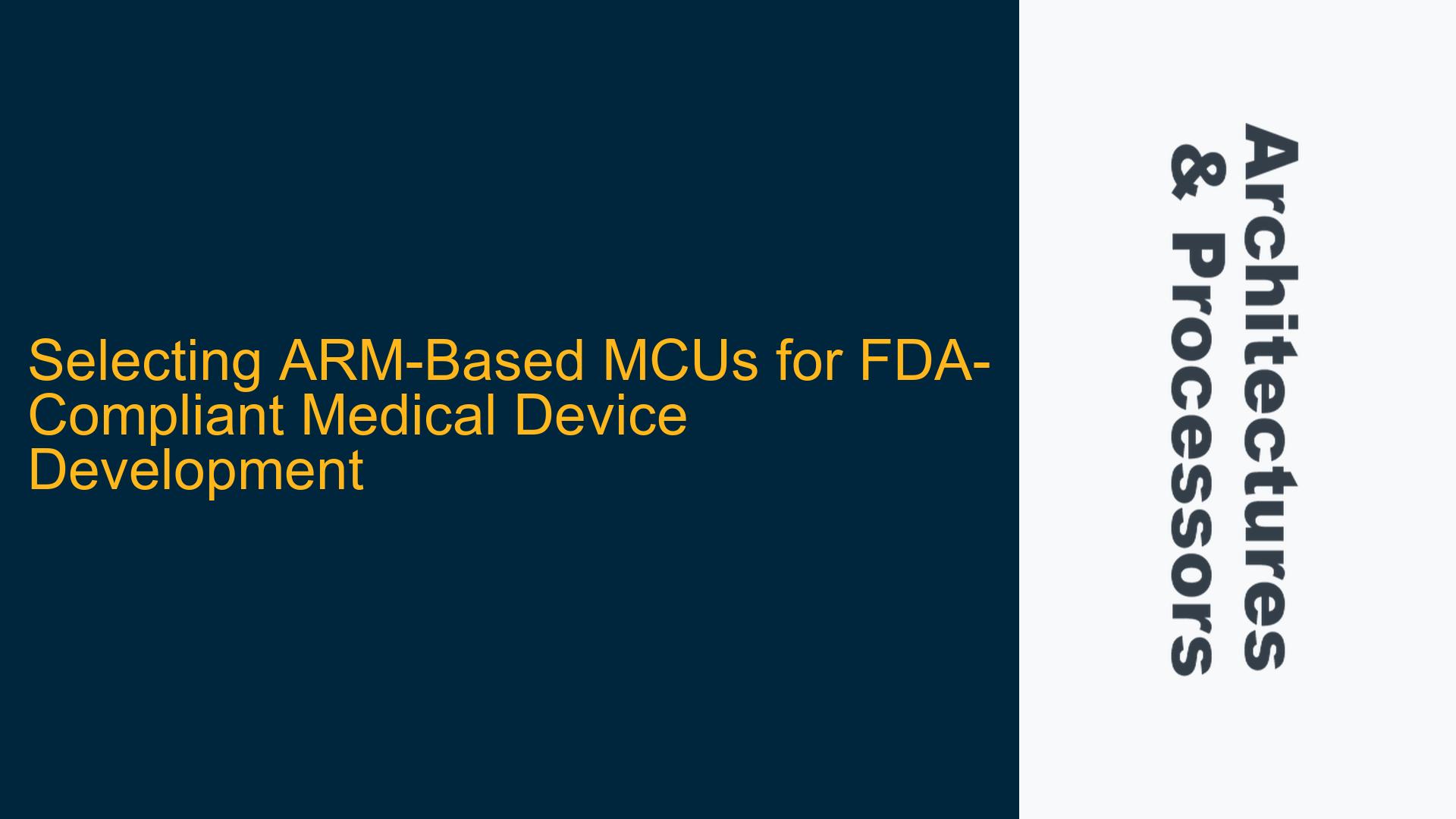ARM Cortex-M Microcontrollers for Medical Device Compliance and FDA Validation
When developing medical devices, selecting the right microcontroller unit (MCU) is critical not only for functionality but also for ensuring compliance with regulatory standards such as those set by the U.S. Food and Drug Administration (FDA). ARM Cortex-M series microcontrollers are widely recognized for their robustness, scalability, and ease of use, making them a popular choice in the medical device industry. However, the ease of FDA verification and validation depends heavily on the specific features of the MCU, the development tools available, and the documentation provided by the manufacturer.
ARM Cortex-M microcontrollers offer a range of cores from the Cortex-M0, designed for ultra-low-power and cost-sensitive applications, to the Cortex-M7, which provides high performance for more complex tasks. For medical devices, the Cortex-M4 is often a sweet spot, offering a balance between performance and power efficiency, along with features like a Floating-Point Unit (FPU) which is beneficial for signal processing tasks common in medical applications.
The key to FDA compliance lies in the ability to demonstrate that the device is safe and effective, which requires thorough documentation and traceability of the software and hardware development process. ARM-based MCUs are advantageous in this regard due to their widespread use and the extensive ecosystem of development tools and middleware that support them. This ecosystem includes Integrated Development Environments (IDEs), real-time operating systems (RTOS), and libraries that are pre-certified for medical use, which can significantly reduce the time and effort required for FDA validation.
Evaluating MCU Features for Medical Device Development and Regulatory Compliance
When evaluating ARM Cortex-M microcontrollers for medical device development, several features stand out as particularly important for ensuring ease of FDA verification and validation:
1. Safety and Reliability Features: Many ARM Cortex-M MCUs come with built-in safety features such as Memory Protection Units (MPU), Error Correcting Code (ECC) on flash memory, and hardware-based watchdog timers. These features help in mitigating risks associated with software faults and hardware failures, which are critical considerations for medical devices.
2. Development Tools and Ecosystem: The availability of comprehensive development tools is crucial. Tools that offer features like static code analysis, code coverage, and traceability can greatly simplify the process of documenting the development process for FDA review. ARM’s own development tools, such as ARM DS-5 and Keil MDK, provide robust support for these requirements.
3. Documentation and Support: Manufacturers that provide detailed documentation, including safety manuals, application notes, and compliance reports, can significantly ease the burden of FDA validation. For instance, STMicroelectronics and Texas Instruments offer extensive documentation for their ARM-based MCUs, which includes detailed descriptions of safety features and guidelines for their use in medical applications.
4. Pre-Certified Software Components: Using software components that are already certified for medical use can reduce the scope of validation required. Many RTOS and middleware providers offer versions of their products that are pre-certified to standards such as IEC 62304, which governs the lifecycle requirements for medical device software.
5. Scalability and Future-Proofing: Medical devices often have long lifecycles, and the ability to scale the hardware platform for future product iterations without significant redesign is a valuable feature. ARM Cortex-M MCUs offer a range of performance options within the same architecture, allowing for scalability.
Implementing ARM Cortex-M MCUs in FDA-Compliant Medical Device Designs
Implementing an ARM Cortex-M microcontroller in a medical device design involves several steps to ensure that the final product will meet FDA requirements:
1. Selecting the Right MCU: The first step is to select an MCU that fits the performance, power, and feature requirements of the medical device. For example, if the device requires advanced signal processing capabilities, a Cortex-M4 or Cortex-M7 with an FPU would be appropriate. If the device is battery-powered and requires ultra-low power consumption, a Cortex-M0+ might be the best choice.
2. Utilizing Development Tools: Leverage development tools that support FDA compliance. This includes using IDEs that integrate with version control systems, provide static code analysis, and support traceability from requirements through to testing. ARM’s Keil MDK, for example, offers these features and is widely used in the industry.
3. Following Design Best Practices: Adhere to design best practices that facilitate FDA validation. This includes implementing modular software design, thorough documentation, and rigorous testing protocols. Using an RTOS that supports preemptive multitasking can also help in creating a more reliable and maintainable codebase.
4. Conducting Thorough Testing: Testing is a critical component of FDA validation. This includes unit testing, integration testing, and system testing. ARM Cortex-M MCUs support various debugging and tracing features that can be used to verify the correct operation of the software. Tools like ARM’s ULINKpro and Tracealyzer can be used to capture and analyze runtime behavior, which is invaluable for demonstrating compliance.
5. Documenting the Development Process: Comprehensive documentation is essential for FDA validation. This includes design specifications, test plans, test results, and traceability matrices. ARM’s development tools often include features that help automate the generation of these documents, reducing the burden on the development team.
6. Engaging with Regulatory Experts: Finally, engaging with regulatory experts early in the design process can help identify potential compliance issues before they become significant problems. Many MCU manufacturers offer support and consulting services to assist with FDA validation.
In conclusion, selecting and implementing an ARM Cortex-M microcontroller in a medical device design requires careful consideration of the MCU’s features, the development tools available, and the documentation provided by the manufacturer. By following best practices and leveraging the extensive ARM ecosystem, developers can significantly ease the process of FDA verification and validation, ensuring that their medical devices meet the stringent requirements for safety and efficacy.






